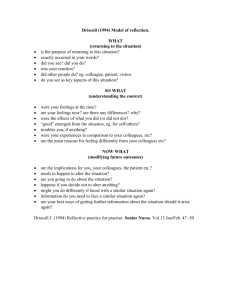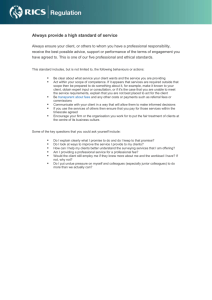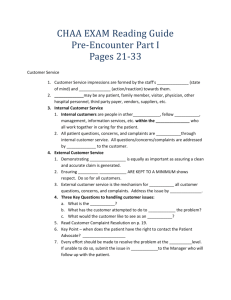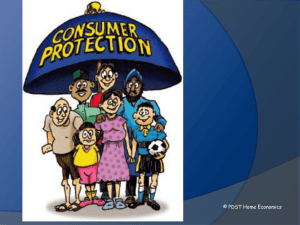Understanding customer service in the retail sector
advertisement
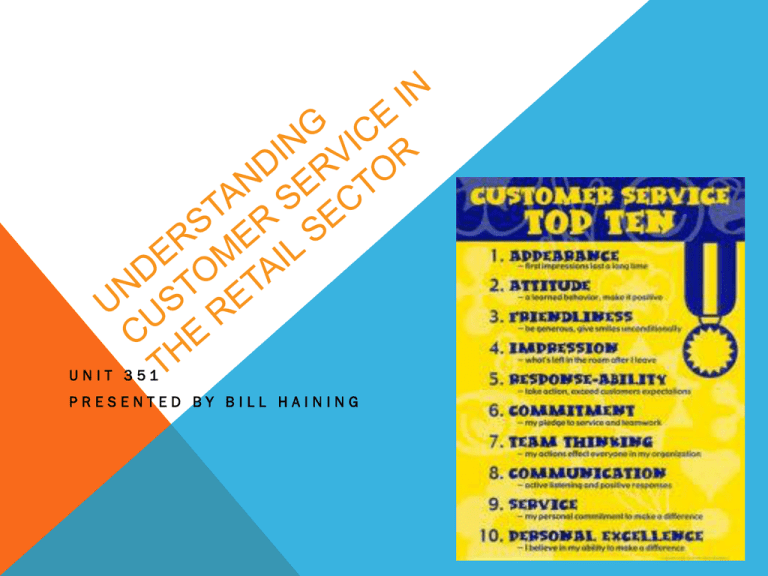
UNIT 351 PRESENTED BY BILL HAINING UNDERSTANDING CUSTOMER SERVICE IN THE RETAIL SECTOR There are four learning outcomes to this unit. The apprentice will be able to: 1. Understand the effect of customer service on retail business. 2. Understand how retail businesses ensure customer service standards are met. 3. Understand how customer complaints are resolved in a retail business. 4. Understand how customer service is monitored in a retail business. CUSTOMER LOYALTY • Customer loyalty is very important to retailers as it costs a lot more to attract a new customer than to retain existing ones. • While there are a number of ways of encouraging customer loyalty, such as through offering loyalty schemes or discounts to regular customers, the cheapest and best way is to offer excellent customer service, as this will encourage the customer to want to return. • Offering excellent customer service means listening to the customer, approaching them at the correct time and in the correct manner and exceeding their expectations. • Customers can find the products and services they are looking for in many of your competitors’ shops; to encourage them to be loyal to yours, you will need to offer them that little bit extra. ORGANISING COLLEAG UES TO MEET CUSTOMER SERVICE STANDARDS • • • • • • • • Excellent customer service is delivered when the team’s work is well organised. It is not enough to simply have as many colleagues as the budget will allow. Organising colleagues involves looking at the minimum number needed to ensure security and cover payment points, fitting rooms, etc., but also involves considering their skills and experience. The right mix of skills and experience is essential if excellent customer service is to be given to customers. You should also be planning for the future by giving colleagues the opportunity to develop their skills by working in areas where they are less experienced alongside more experienced colleagues. Setting customer service standards such as having sufficient colleagues, using ‘welcome’ phrases or even a good returns policy encourages customer loyalty. If colleagues operate to the correct standard then customers will feel valued and return to spend their money and increase sales. The relationship between customer service standards and customer loyalty is that they go hand in hand and one improves the other. CONTINGENCY PLANNING • When creating a colleague rota you will need to know what tasks have to be carried out during that period and make sure that there is the correct number of colleagues with the correct skills available. • You will also need to look at the individuals’ working hours, any known holidays and the trading patterns expected; unusual trading periods will cause an adjustment to the number of colleagues needed. • There also needs to be a contingency plan for sickness cover; have someone on call in case of emergency. RESOLVING CUSTOMER COMPLAINTS • A challenge to the delivery of excellent customer service is presented when customers complain. • Complaints fall into three categories; product related, service related or colleague related. • The most common is product related complaints. • These refer to products which have not met the expectations of the customer. • Service related complaints refer to a failure of the organisation to deliver the service that they had offered. • Colleague related complaints refer to the customer’s perception of the colleague’s attitude. RESOLVING CUSTOMER COMPLAINTS • Whichever type of complaint you are asked to deal with, you will need to use your experience in dealing with customers. • Use listening skills to reassure the customer that you are giving them your full attention and questioning skills to find out the real cause of the complaint and what the customer would like you to do to satisfy their needs. • Use closed questions to get definite answers, open questions to get descriptive answers and probing questions to get further detail. • Be aware of the customer’s body language; if they are angry keep a neutral facial expression and allow them to express their anger; if they are confused use an open body position and hand gestures to direct them towards a decision. NEGOTIATION • • • • • • • • • Once you have all of the information you will be in a position to negotiate a solution that satisfies the customer and exceeds their expectations. Going the extra mile can turn the customer’s dissatisfaction into delight. Try to find out what they would be satisfied with; they may only be looking for an acknowledgement that they are right and you have let them down. Negotiation is about finding a solution so that everybody is happy. When negotiating, it is important that you understand the company policy on dealing with complaints. This may be to offer a discount, a refund, an exchange, a credit voucher or a free gift. However, it is more important to understand that the customer has rights under the Sale and Supply of Goods and Services Act that may go further than your company policy. For instance, if goods are faulty, incorrectly described or not fit for purpose, the customer is entitled to ask for their money back, request a repair or replacement or claim compensation. NEGOTIATION • Even if your company policy says goods must be returned within 30 days for a refund, the legislation says the customer has up to six years after purchase to demand damages in the case of faulty goods. • Your company policy may say that refunds cannot be given if a receipt is not produced, but legislation says the customer has to produce proof of purchase. • This could be a credit card bill, a bank statement or even simply a statement that they purchased the goods from you. • The legislation does not differentiate between goods sold at full price and sale goods or between new goods and second-hand goods. • Only if a fault is pointed out to the customer before purchase or should have been obvious are they not entitled to a refund. • Displaying a sign saying ‘No refund on sale goods’ is illegal. MONITORING CUSTOMER SERVICE • It is important to monitor the delivery and effectiveness of customer service in order to ensure that customer expectations are being met and exceeded. • Monitoring will also highlight where improvements can be made. • Methods of monitoring the customer service being delivered by the team include the collection of formal and informal customer feedback. • Formal feedback can be collected using questionnaires, surveys, mystery shoppers, customer records, suggestion forums and market research. • Informal feedback can be collected by word of mouth, thank you letters and complaints. MONITORING CUSTOMER SERVICE • • • • • Monitoring individual performance includes the annual appraisal or periodic review. These give you the opportunity to discuss with the individual their training and development needs. The review identifies the skills that are already developed, training which is required, and objectives that are agreed. This leads to a personal development plan identifying Key Performance Indicators (KPIs), which are measurements of the individual’s performance against the agreed goals. The measurement may be: ✓✓ objective, e.g. make six sales per day or ✓✓ subjective, e.g. improve your approach to customers • • Subjective measurement may be achieved through observation of the individual over the agreed period. While the individual will be aware that they are being observed it is important that the observation itself does not affect the way they carry out the task. MONITORING CUSTOMER SERVICE • Mystery shoppers can be used to measure individual and team key performance indicators for the retailer. • The results of these can be fed back to the retail organisation and in large retailers this can be shared in company updates and overall performance records, monthly and annually. • Any formal monitoring helps to record incidents where individuals or stores have performed particularly well or not. Individual feedback to colleagues should be specific and constructive and confidential. THE END Thanks and good luck



